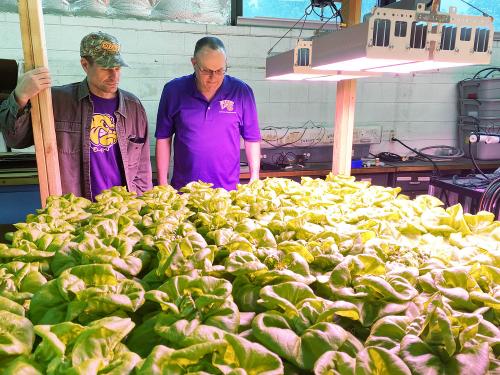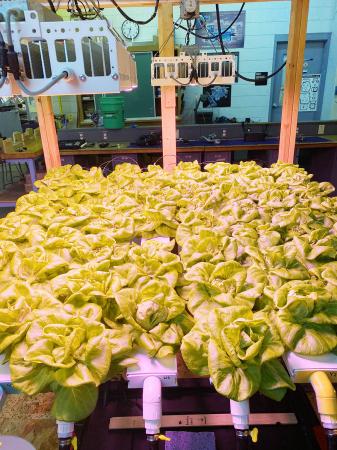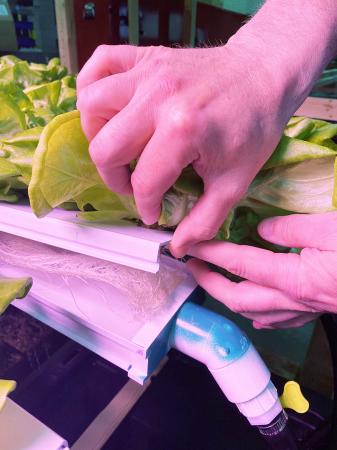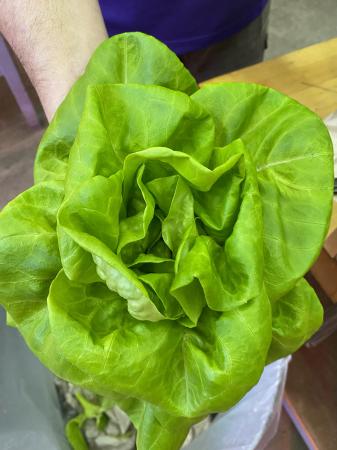University News
Federal Agriculture Grant to Elevate Hydroponic Lettuce Production at WIU
June 16, 2020
MACOMB, IL – Collaborative agriculture research at Western Illinois University, with a boost from a recently-awarded federal grant, means opportunities for faculty and students to study hydroponic lettuce production, with the aid of hyperspectral reflectance technology, in future semesters.
WIU Agriculture Assistant Professors Shelby Henning and Dan Atherton began collaborating two years ago, when Henning and his horticulture students, along with technical assistance from Atherton, built a small hydroponic lettuce production system in the Ag Mech Shop in Knoblauch Hall's basement. The system was constructed of inexpensive materials, the bulk of which was PVC pipe, silicone caulk and recycled lumber. A single horticultural LED lamp served as the only light source for the lettuce grown in the student-made system.
"Basically, we wanted to see if our simple system using the PVC pipe would work," said Henning. "It worked extraordinarily well, which flew in the face of what I thought would happen."
The two professors quickly learned the expertise each possesses melded together naturally into the indoor lettuce production project – Henning contributing (soft science) vegetable production expertise and Atherton with (hard science) computer science and precision agriculture components.
Henning and Atherton have since been refining the production of ‘Rex' butterhead lettuce using two prototype lettuce production systems that use rectangular, commercial-grade hydroponic channels in lieu of round PVC pipe, and multiple LED lighting units, to provide sufficient light for all of the growing plants. Atherton and students in his shop skills class constructed the second prototype system, using the first system Atherton had created as a model.
Henning and Atherton are now attempting to improve nutrient recommendations for hydroponic lettuce in order to save producers both time and input costs.
"The nutrient solution within the system is replaced at set dates to determine the optimal time frame for replacement," Atherton said. "Some advantages of the lettuce grown in this hydroponic system are that no pesticides are used, the timeframe from planting to harvest is greatly accelerated and the shelf-life of the crop far surpasses that to lettuce grown in the field."
The latest lettuce was planted April 13 and was ready for harvest in mid-May.
Atherton compares the taste of the basement-produced lettuce to the difference in screen quality between a 4K television and a traditional set.
"It's tastier," said Atherton. "And, it doesn't get any closer to the farm than picking it and putting it straight to a plate, which is something you certainly can do with lettuce produced this way."
From about three weeks after seeding to harvest, the growing channels housing the lettuce are disconnected from the system and placed in a custom-made stand to flood the lettuce plants with light. For each lettuce plant, a hyperspectral spectrometer is used to repeatedly capture spectral reflectance signatures (curves) for each plant.
The curves display the reflectance percentages from roughly 350 – 1000 nm, which includes both visible and near-infrared wavelength regions. The curves are then analyzed using advanced software algorithms. The end result is the early detection of nutrient deficiencies in the lettuce crop far before they become visible to the human eye.
The awarded grant, about $26,000 from the United States Department of Agriculture and awarded by the Illinois Department of Agriculture Specialty Crop Grant Program, will facilitate construction of a new system double the size of the existing prototypes. The new system will be located on the first floor of Knoblauch Hall and will include many refinements to the lettuce production and data acquisition process. Also, additional lighting technologies will be evaluated for lettuce production in the new system.
"A commercial grower's operation would be many times larger than our experimental system, so any refinements in water and fertilizer utilization resulting from this research would be significant," said Atherton. "Our project will help us better understand the relationship between the timing of nutrient solution replacement and lettuce quality."
Early in the Spring 2020 semester, some of the harvested lettuce was provided to the Knoblauch Cafe, which gives WIU's recreation, park and tourism administration (RPTA) students hands-on experience running a foodservice facility.
WIU School of Agriculture Director Andy Baker said this project also provides a great opportunity to begin growing food for students on campus.
"This system has the potential of growing 400 heads of lettuce per month," he said. "It also has the potential of assisting with WIU's food pantry, if there is a surplus of produce. I appreciate both Dr. Atherton and Dr. Henning for their efforts in their awarded grant to provide a unique learning opportunity for our students and the potential of providing fresh, local produce for our food services on campus."
Both professors plan to use the production processes in their fall classes.
In addition to the lettuce research, Henning is also working with WIU Chemistry Assistant Professor Mette Soendergaard and University students to study the cancer-prevention qualities of heirloom tomatoes, which he grows hydroponically in the School of Agriculture's greenhouse facilities.
For more information on the WIU School of Agriculture, visit wiu.edu/ag.
Posted By: Jodi Pospeschil (JK-Pospeschil@wiu.edu)
Office of University Communications & Marketing





Connect with us: